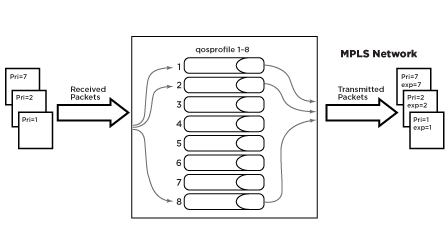Mapping Dot1p to EXP Bits
The priority of Ethernet tagged packets can be mapped into the MPLS network and vice versa using the switch fabric qosprofile.
Ethernet packets are assigned to a qosprofile by enabling dot1p examination. MPLS packets are assigned to a qosprofile by enabling exp examination. When the packets egress the switch, the dot1p and exp bit fields can be overwritten.
Enabling EXP replacement instructs the switch to overwrite both the dot1p field and the exp field in the outer most label.

By default, when dot1p examination and exp replacement are not enabled, all received packets are routed through qosprofile qp1 and the packets are transmitted with the dot1p and exp value of zero. As shown in Mapping Dot1p to EXP Bits, the switch can be configured to route packets to a specific qosprofile based on the dot1p value in the 802.1p bit field. In this example dot1p examination is enabled. By default, when dot1p examination is enabled, packets are sent to the qosprofile that corresponds dot1p type to qosprofile mapping.
This mapping can be viewed using show dot1p type. By default, MPLS exp replacement is disabled. By enabling MPLS exp replacement, MPLS packets are transmitted with the configured qosprofile dot1p and exp value. By default, these values correspond to the qosprofile. Qosprofile 1 overwrites the dot1p and exp fields with 0, qosprofile 2 overwrites the dot1p and exp fields with 1, and so on.
To configure the reverse packet flow, mpls exp examination and dot1p replacement must be configured. Enabling MPLS exp examination instructs the switch to route received MPLS packets to a qosprofile based on the EXP value. Enabling dot1p replacement instructs the switch to write the dot1p value in the transmitted packet.

